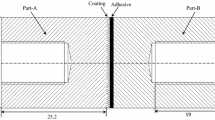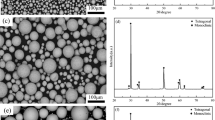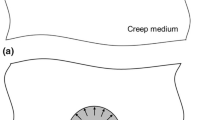Abstract
Background
The elastic–plastic fracture toughness (Jc) is an important mechanical parameter for studying the failure behavior of air plasma-sprayed (APS) thermal barrier coatings (TBC) at high temperatures.
Objective
This study aims to: (1) develop an effective test method to characterize the Jc of TBC at high temperatures; (2) acquire accurate Jc data for TBC at high temperatures; (3) analyze the influence of plasticity of top-coat on the Jc characterization.
Methods
The elastic–plastic Ramberg–Osgood equation of the ceramic top-coat and the deformation fields of single edge notched tension (SENT) specimens were measured by high-temperature in-situ tension with digital image correlation (DIC) system. The Jc of TBC was calculated by the numerical J-integral with DIC-measured (DIC-J) deformation fields by adopting Ramberg–Osgood equation of the top-coat. The finite element analysis (FEA) method was adopted to analyze the influence of plasticity of top-coat on the Jc characterization.
Results
The curves of Jc varying with crack propagation length (Δa) of TBC were obtained and were expressed as JR = 24.47 × [ 1 + 1.0446 × (\(\widetilde{\Delta a}\))0.7624] J/m2 and JR = 16.52 × [ 1 + 1.4806 × (\(\widetilde{\Delta a}\))0.6742] J/m2 at 800 and 1000 ℃, respectively.
Conclusions
A high-temperature in-situ tensile test of SENT specimens combined with the DIC-J method was developed to characterize Jc of TBC. The Jc of TBC displays a rising resistance curve behavior, and FEA results indicated that Jc would be underestimated without considering the plasticity of the top-coat at 800 and 1000 ℃.
















Similar content being viewed by others
Data Availability
Raw images and data generated during the current study are available from the corresponding author upon reasonable request.
References
Lepeshkin AR, Bichkov NG, Ilinskaja OI, Nazarov VV (2017) Investigations of thermal barrier coatings of turbine parts using gas flame heating. J Phys Conf Ser 899:072002. https://doi.org/10.1088/1742-6596/899/7/072002
Rudrapatna N, Lutz B, Kington H (2022) Next Generation Air Plasma Spray Porous Thermal Barrier Coatings for Gas Turbine Combustors. J Eng Gas Turbines Power. https://doi.org/10.1115/1.4055919
Bose S, DeMasi-Marcin J (1997) Thermal barrier coating experience in gas turbine engines at Pratt & Whitney. J Therm Spray Technol 6:99–104. https://doi.org/10.1007/BF02646318
Bison P, Cernuschi F, Capelli S (2011) A thermographic technique for the simultaneous estimation of in-plane and in-depth thermal diffusivities of TBCs. Surf Coat Technol 205:3128–3133. https://doi.org/10.1016/j.surfcoat.2010.11.013
Kwon J-Y, Lee J-H, Jung Y-G, Paik U (2006) Effect of bond coat nature and thickness on mechanical characteristic and contact damage of zirconia-based thermal barrier coatings. Surf Coat Technol 201:3483–3490. https://doi.org/10.1016/j.surfcoat.2006.07.240
Ebrahimzade V, Haasler D, Malzbender J (2021) Failure mechanism and lifetime of various laser-drilled APS-TBC systems under LCF conditions. Eng Fail Anal 127:105526. https://doi.org/10.1016/j.engfailanal.2021.105526
Naumenko D, Shemet V, Singheiser L, Quadakkers WJ (2009) Failure mechanisms of thermal barrier coatings on MCrAlY-type bondcoats associated with the formation of the thermally grown oxide. J Mater Sci 44:1687–1703. https://doi.org/10.1007/s10853-009-3284-3
Gell M, Xie L, Jordan EH, Padture NP (2004) Mechanisms of spallation of solution precursor plasma spray thermal barrier coatings. Surf Coat Technol 188–189:101–106. https://doi.org/10.1016/j.surfcoat.2004.08.004
Renusch D, Echsler H, Schütze M (2004) Progress in life time modeling of APS-TBC Part II: critical strains, macro-cracking, and thermal fatigue. Mater High Temp 21:77–86. https://doi.org/10.1179/mht.2004.011
Giolli C, Scrivani A, Rizzi G et al (2009) Failure Mechanism for Thermal Fatigue of Thermal Barrier Coating Systems. J Therm Spray Technol 18:223–230. https://doi.org/10.1007/s11666-009-9307-4
Ang ASM, Berndt CC (2014) A review of testing methods for thermal spray coatings. Int Mater Rev 59:179–223. https://doi.org/10.1179/1743280414Y.0000000029
Zhu W, Wu Q, Yang L, Zhou YC (2020) In situ characterization of high temperature elastic modulus and fracture toughness in air plasma sprayed thermal barrier coatings under bending by using digital image correlation. Ceram Int 46:18526–18533. https://doi.org/10.1016/j.ceramint.2020.04.158
Mao WG, Chen YY, Wang YJ et al (2018) A multilayer structure shear lag model applied in the tensile fracture characteristics of supersonic plasma sprayed thermal barrier coating systems based on digital image correlation. Surf Coat Technol 350:211–226. https://doi.org/10.1016/j.surfcoat.2018.07.013
Yao WB, Dai CY, Mao WG et al (2012) Acoustic emission analysis on tensile failure of air plasma-sprayed thermal barrier coatings. Surf Coat Technol 206:3803–3807. https://doi.org/10.1016/j.surfcoat.2012.03.050
Liu H, Liang L, Wang Y, Wei Y (2016) Fracture Characteristics and Damage Evolution of Coating Systems Under Four-Point Bending. Int J Appl Ceram Technol 13:1043–1052. https://doi.org/10.1111/ijac.12605
Malzbender J, Steinbrech RW (2012) Fracture resistance of atmospheric plasma sprayed thermal barrier coatings. Surf Coat Technol 209:97–102. https://doi.org/10.1016/j.surfcoat.2012.08.035
Jiang P, Fan X, Sun Y et al (2018) Bending-driven failure mechanism and modelling of double-ceramic-layer thermal barrier coating system. Int J Solids Struct 130–131:11–20. https://doi.org/10.1016/j.ijsolstr.2017.10.024
Zhang X, Watanabe M, Kuroda S (2013) Effects of residual stress on the mechanical properties of plasma-sprayed thermal barrier coatings. Eng Fract Mech 110:314–327. https://doi.org/10.1016/j.engfracmech.2013.08.016
Xiao B, Huang X, Robertson T et al (2020) Sintering resistance of suspension plasma sprayed 7YSZ TBC under isothermal and cyclic oxidation. J Eur Ceram Soc 40:2030–2041. https://doi.org/10.1016/j.jeurceramsoc.2019.12.046
Gao M, Xu N, Zhang J et al (2021) Influence of mechanical properties on thermal shock resistance of TBCs. Surf Eng 37:572–580. https://doi.org/10.1080/02670844.2020.1812478
Chen Y, Zhang X, Zhao X et al (2019) Measurements of elastic modulus and fracture toughness of an air plasma sprayed thermal barrier coating using micro-cantilever bending. Surf Coat Technol 374:12–20. https://doi.org/10.1016/j.surfcoat.2019.05.031
Li CJ, Wang WZ, He Y (2004) Dependency of fracture, toughness of plasma sprayed Al2O3 coatings on lamellar structure. J Therm Spray Technol 13:425–431. https://doi.org/10.1361/10599630419364
Ostojic P, Mcpherson R (1988) Determining the Critical Strain-Energy Release Rate of Plasma-Sprayed Coatings Using a Double-Cantilever-Beam Technique. J Am Ceram Soc 71:891–899. https://doi.org/10.1111/j.1151-2916.1988.tb07542.x
Thurn G, Schneider GA, Bahr H-A, Aldinger F (2000) Toughness anisotropy and damage behavior of plasma sprayed ZrO2 thermal barrier coatings. Surf Coat Technol 123:147–158. https://doi.org/10.1016/S0257-8972(99)00528-9
Singh M, Sahu PK, Sampath S, Jonnalagadda KN (2024) Fracture toughness of freestanding plasma sprayed yttria stabilized zirconia coatings via in situ tensile experiments. J Eur Ceram Soc 44:2499–2511. https://doi.org/10.1016/j.jeurceramsoc.2023.10.074
Bai H, Wang Z, Luo S et al (2023) A modified single edge V-notched beam method for evaluating surface fracture toughness of thermal barrier coatings. Appl Math Mech 44:693–710. https://doi.org/10.1007/s10483-023-3001-6
Zhu X-K, Joyce JA (2012) Review of fracture toughness (G, K, J, CTOD, CTOA) testing and standardization. Eng Fract Mech 85:1–46. https://doi.org/10.1016/j.engfracmech.2012.02.001
Alotaibi M (2022) Application of an Image-Based Model of the Elastic Modulus of Porous Thermal Barrier Coatings. Met Mater Int 28:1794–1808. https://doi.org/10.1007/s12540-021-01084-6
Waki H, Oikawa A, Kato M et al (2014) Evaluation of the Accuracy of Young’s Moduli of Thermal Barrier Coatings Determined on the Basis of Composite Beam Theory. J Therm Spray Technol 23:1291–1301. https://doi.org/10.1007/s11666-014-0145-7
Qu Z, Wei K, He Q et al (2018) High temperature fracture toughness and residual stress in thermal barrier coatings evaluated by an in-situ indentation method. Ceram Int 44:7926–7929. https://doi.org/10.1016/j.ceramint.2018.01.230
Baufeld B, Messerschmidt U, Bartsch M, Baither D (1995) Plasticity of Cubic Zirconia between 700 °C and 1150 °C Observed by Macroscopic Compression and by In Situ Tensile Straining Tests. Key Eng Mater 97–98:431–436. https://doi.org/10.4028/www.scientific.net/KEM.97-98.431
Cho J, Li J, Li Q et al (2018) In-situ high temperature micromechanical testing of ultrafine grained yttria-stabilized zirconia processed by spark plasma sintering. Acta Mater 155:128–137. https://doi.org/10.1016/j.actamat.2018.05.062
Messerschmidt U, Baither D, Baufeld B, Bartsch M (1997) Plastic deformation of zirconia single crystals: a review. Mater Sci Eng A 233:61–74. https://doi.org/10.1016/S0921-5093(97)00050-6
He R, Qu Z, Pei Y, Fang D (2017) High temperature indentation tests of YSZ coatings in air up to 1200°C. Mater Lett 209:5–7. https://doi.org/10.1016/j.matlet.2017.07.091
Jeon S-W, Lee K-W, Kim JY et al (2017) Estimation of fracture toughness of metallic materials using instrumented indentation: critical indentation stress and strain model. Exp Mech 57:1013–1025. https://doi.org/10.1007/s11340-016-0226-2
Jungk J, Boyce B, Buchheit T et al (2006) Indentation fracture toughness and acoustic energy release in tetrahedral amorphous carbon diamond-like thin films. Acta Mater 54:4043–4052. https://doi.org/10.1016/j.actamat.2006.05.003
ASTM E1820–23B (2023) Standard test method for measurement of fracture toughness
Erdogan F (2000) Fracture mechanics. Int J Solids Struct 37:171–183. https://doi.org/10.1016/S0020-7683(99)00086-4
Rice JR, Rosengren GF (1968) Plane strain deformation near a crack tip in a power-law hardening material. J Mech Phys Solids 16:1–12. https://doi.org/10.1016/0022-5096(68)90013-6
McNeill SR, Peters WH, Sutton MA (1987) Estimation of stress intensity factor by digital image correlation. Eng Fract Mech 28:101–112. https://doi.org/10.1016/0013-7944(87)90124-X
Roux S, Réthoré J, Hild F (2009) Digital image correlation and fracture: An advanced technique for estimating stress intensity factors of 2D and 3D cracks. J Phys Appl Phys. https://doi.org/10.1088/0022-3727/42/21/214004
Yates JR, Zanganeh M, Tai YH (2010) Quantifying crack tip displacement fields with DIC. Eng Fract Mech 77:2063–2076. https://doi.org/10.1016/j.engfracmech.2010.03.025
Becker TH, Mostafavi M, Tait RB, Marrow TJ (2012) An approach to calculate the J-integral by digital image correlation displacement field measurement. Fatigue Fract Eng Mater Struct 35:971–984. https://doi.org/10.1111/j.1460-2695.2012.01685.x
Jandejsek I, Gajdoš L, Šperl M, Vavřík D (2017) Analysis of standard fracture toughness test based on digital image correlation data. Eng Fract Mech 182:607–620. https://doi.org/10.1016/j.engfracmech.2017.05.045
Yin Y, Wu L, Li J, Xie H (2019) High-Temperature Fracture Mechanics Parameter Measurement and Yielding Zone Analysis of Superalloy GH4169 Based on Single-Lens 3D Digital Image Correlation. Exp Mech 59:953–962. https://doi.org/10.1007/s11340-019-00490-7
Yin Y, He W, Xie H, Wu L (2020) High-temperature fatigue crack propagation study of superalloy GH4169 by single-lens 3D digital image correlation. Sci China Technol Sci 63:693–704. https://doi.org/10.1007/s11431-019-9525-3
Kodaira Y, Miura T, Ito S et al (2021) Evaluation of crack propagation behavior of porous polymer membranes. Polym Test 96:107124. https://doi.org/10.1016/j.polymertesting.2021.107124
Tracy J, Waas A, Daly S (2015) Experimental assessment of toughness in ceramic matrix composites using the J-integral with digital image correlation part II: application to ceramic matrix composites. J Mater Sci 50:4659–4671. https://doi.org/10.1007/s10853-015-9017-x
Ouyang J, Yang W, Cao P, Han B (2023) The fracture behaviour of cement bitumen emulsion mixture through the digital image correlation (DIC) method. Int J Pavement Eng 24:2220065. https://doi.org/10.1080/10298436.2023.2220065
ASTM E21–20 (2021) Standard test methods for elevated temperature tension tests of metallic materials
ASTM C1273–18 (2018) Standard test method for tensile strength of monolithic advanced ceramics at ambient temperatures
Gao W, Lu J, Zhou J et al (2022) Effect of grain size on deformation and fracture of Inconel718: an in-situ SEM-EBSD-DIC investigation. Mater Sci Eng A 861:144361. https://doi.org/10.1016/j.msea.2022.144361
ASTM C1421–18 (2018) Standard test methods for determination of fracture toughness of advanced ceramics at ambient temperature
Kumar A, Moledina J, Liu Y et al (2021) Nano-micro-structured 6%–8% YSZ thermal barrier coatings: a comprehensive review of comparative performance analysis. Coatings 11:1474. https://doi.org/10.3390/coatings11121474
Yoneyama S, Arikawa S, Kusayanagi S, Hazumi K (2014) Evaluating J-integral from displacement fields measured by digital image correlation. Strain 50:147–160. https://doi.org/10.1111/str.12074
Justin B (2023) 2D Digital image correlation matlab software
Arrayago I, Real E, Gardner L (2015) Description of stress–strain curves for stainless steel alloys. Mater Des 87:540–552. https://doi.org/10.1016/j.matdes.2015.08.001
Bruck HA, McNeill SR, Sutton MA, Peters WH (1989) Digital image correlation using Newton-Raphson method of partial differential correction. Exp Mech 29:261–267. https://doi.org/10.1007/BF02321405
Hutchinson JW (1968) Singular behaviour at the end of a tensile crack in a hardening material. J Mech Phys Solids 16:13–31. https://doi.org/10.1016/0022-5096(68)90014-8
Rahman S (1995) A stochastic model for elastic-plastic fracture analysis of circumferential through-wall-cracked pipes subject to bending. Eng Fract Mech 52:265–288. https://doi.org/10.1016/0013-7944(95)00018-Q
Luo S, Bai H, Huang R et al (2022) An in situ micro-indentation apparatus for investigating mechanical parameters of thermal barrier coatings under temperature gradient. Rev Sci Instrum 93:045102. https://doi.org/10.1063/5.0083087
Lu Z, Feng Y, Peng G et al (2014) Estimation of surface equi-biaxial residual stress by using instrumented sharp indentation. Mater Sci Eng A 614:264–272. https://doi.org/10.1016/j.msea.2014.07.041
Suresh S, Giannakopoulos AE (1998) A new method for estimating residual stresses by instrumented sharp indentation. Acta Mater 46:5755–5767. https://doi.org/10.1016/S1359-6454(98)00226-2
Ma L, Zhang L, Guo F et al (2021) High-Temperature Mechanical Behavior Assessment based on a Developed Constitutive Model of Inconel 718 Fabricated by Selective Laser Melting. Adv Eng Mater 23:2100232. https://doi.org/10.1002/adem.202100232
Yin Q, Wen Z, Wang J et al (2022) Microstructure characterization and damage coupled constitutive modeling of nickel-based single-crystal alloy with different orientations. Mater Sci Eng A 853:143761. https://doi.org/10.1016/j.msea.2022.143761
Wei Q, Zhu J, Chen W (2016) Anisotropic Mechanical Properties of Plasma-Sprayed Thermal Barrier Coatings at High Temperature Determined by Ultrasonic Method. J Therm Spray Technol 25:605–612. https://doi.org/10.1007/s11666-016-0378-8
ASTM D6068–10 (2018) Standard test method for determining J-R Curves of plastic materials
Anderson TL (2017) Fracture mechanics: fundamentals and applications, 4th edn. CRC Press, Boca Raton
Acknowledgements
This work is supported by National Natural Science Foundation of China (Nos.12172048, 12027901) and National Science and Technology Major Project (2019-VII-0007-0147).
Author information
Authors and Affiliations
Corresponding authors
Ethics declarations
Competing Interest
The authors declare that they have no known competing financial interests or personal relationships that could have appeared to influence the work reported in this paper.
Additional information
Publisher's Note
Springer Nature remains neutral with regard to jurisdictional claims in published maps and institutional affiliations.
Rights and permissions
Springer Nature or its licensor (e.g. a society or other partner) holds exclusive rights to this article under a publishing agreement with the author(s) or other rightsholder(s); author self-archiving of the accepted manuscript version of this article is solely governed by the terms of such publishing agreement and applicable law.
About this article
Cite this article
Bai, H., Qu, Z., Yang, H. et al. In-Situ Characterization on Fracture Toughness of Thermal Barrier Coatings Under Tension by J-Integral with Digital Image Correlation at High Temperatures. Exp Mech (2024). https://doi.org/10.1007/s11340-024-01061-1
Received:
Accepted:
Published:
DOI: https://doi.org/10.1007/s11340-024-01061-1




